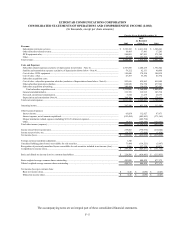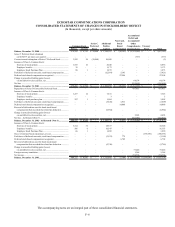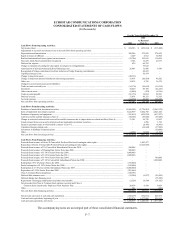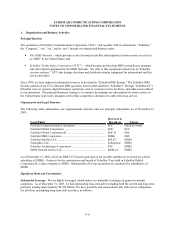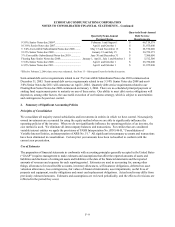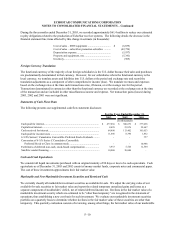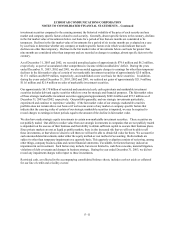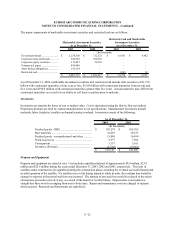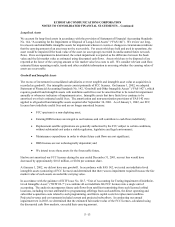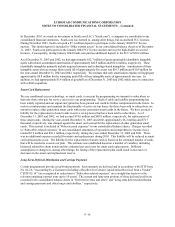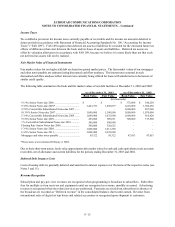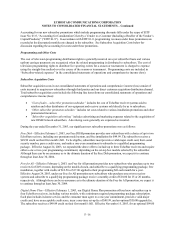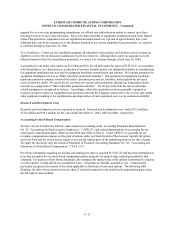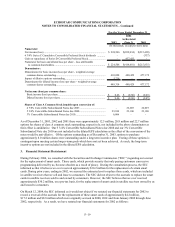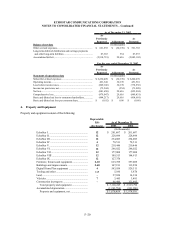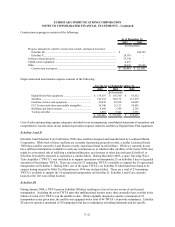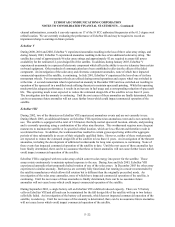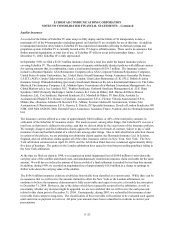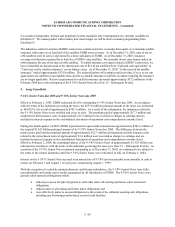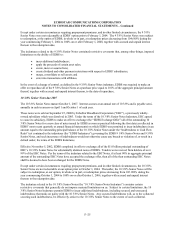Dish Network 2003 Annual Report Download - page 82
Download and view the complete annual report
Please find page 82 of the 2003 Dish Network annual report below. You can navigate through the pages in the report by either clicking on the pages listed below, or by using the keyword search tool below to find specific information within the annual report.
ECHOSTAR COMMUNICATIONS CORPORATION
NOTES TO CONSOLIDATED FINANCIAL STATEMENTS – Continued
F–15
Income Taxes
We establish a provision for income taxes currently payable or receivable and for income tax amounts deferred to
future periods in accordance with Statement of Financial Accounting Standards No. 109, “Accounting for Income
Taxes” (“FAS 109”). FAS 109 requires that deferred tax assets or liabilities be recorded for the estimated future tax
effects of differences that exist between the book and tax bases of assets and liabilities. Deferred tax assets are
offset by valuation allowances in accordance with FAS 109, because we believe it is more likely than not that such
net deferred tax assets will not be realized.
Fair Market Value of Financial Instruments
Fair market values for our high-yield debt are based on quoted market prices. The fair market values of our mortgages
and other notes payable are estimated using discounted cash flow analyses. The interest rates assumed in such
discounted cash flow analyses reflect interest rates currently being offered for loans with similar terms to borrowers of
similar credit quality.
The following table summarizes the book and fair market values of our debt facilities at December 31, 2003 and 2002:
As of December 31, 2003 As of December 31, 2002
Book Value Fair Value Book Value Fair Value
(In thousands)
9 1/4% Senior Notes due 2006...................................... $ - $ - $ 375,000 $ 386,250
9 3/8% Senior Notes due 2009*.................................... 1,423,351 1,498,077 1,625,000 1,706,250
4 7/8% Convertible Subordinated Notes due 2007........ - - 1,000,000 897,960
10 3/8% Senior Notes due 2007 ................................... 1,000,000 1,100,000 1,000,000 1,070,000
5 3/4% Convertible Subordinated Notes due 2008 ....... 1,000,000 1,035,000 1,000,000 910,420
9 1/8% Senior Notes due 2009...................................... 455,000 509,031 700,000 717,500
3 % Convertible Subordinated Notes due 2010 ............ 500,000 500,000 - -
Floating Rate Senior Notes due 2008............................ 500,000 520,625 - -
5 3/4% Senior Notes due 2008...................................... 1,000,000 1,011,250 - -
6 3/8% Senior Notes due 2011...................................... 1,000,000 1,025,000 - -
Mortgages and other notes payable ............................... 59,322 59,322 47,053 47,053
*These notes were redeemed February 2, 2004.
Due to their short-term nature, book value approximates fair market value for cash and cash equivalents, trade accounts
receivable, net of allowance and current liabilities for the periods ending December 31, 2003 and 2002.
Deferred Debt Issuance Costs
Costs of issuing debt are generally deferred and amortized to interest expense over the terms of the respective notes (see
Notes 5 and 15).
Revenue Recognition
Subscription and pay-per-view revenues are recognized when programming is broadcast to subscribers. Subscriber
fees for multiple set-top receivers and equipment rental are recognized as revenue, monthly as earned. Advertising
revenue is recognized when the related services are performed. Payments received from subscribers in advance of
the broadcast are recorded as “Deferred revenue” in the consolidated balance sheets until earned. Revenue from
international sales of digital set-top boxes and related accessories is recognized upon shipment to customers.


